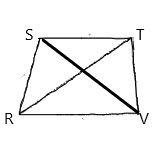
a.
To find:The bases of isosceles trapezoid RSTV if
a.
Answer to Problem 7PSA
The bases are
Explanation of Solution
Given:
In isosceles trapezoid RSTV,
Calculation:

The below property is used:
In any isosceles trapezoid, two opposite sides (the bases) are parallel, and the other sides (the legs) are of equal length.
b.
To find: The diagonals of isosceles trapezoid RSTV if
b.
Answer to Problem 7PSA
The diagonals are
Explanation of Solution
Given:
In isosceles trapezoid RSTV,
Calculation:

The below property is used:
A diagonal is a line segment joining two vertices of a
The diagonals of an isosceles trapezoid have the same length.
c.
To find: The legs of isosceles trapezoid RSTV if
c.
Answer to Problem 7PSA
The legs are
Explanation of Solution
Given:
In isosceles trapezoid RSTV,
Calculation:

The below property is used:
In any isosceles trapezoid, two opposite sides (the bases) are parallel, and the other sides (the legs) are of equal length.
d.
To find: The lower base
d.
Answer to Problem 7PSA
The lower base angles are angle
Explanation of Solution
Given:
In isosceles trapezoid RSTV,
Calculation:

The below property is used:
In any isosceles trapezoid, two opposite sides (the bases) are parallel, and the other sides (the legs) are of equal length.
RV is lower base of an isosceles trapezoid RSTV.
The lower base angles are
e.
To find: The upper base angles of isosceles trapezoid RSTV if
e.
Answer to Problem 7PSA
The upper base angles are angle
Explanation of Solution
Given:
In isosceles trapezoid RSTV,
Calculation:

The below property is used:
In any isosceles trapezoid, two opposite sides (the bases) are parallel, and the other sides (the legs) are of equal length.
ST is upper base of an isosceles trapezoid RSTV.
The upper base angles are
f.
To find: The pair of conjugate alternate angles of isosceles trapezoid RSTV if
f.
Answer to Problem 7PSA
The conjugate alternate angles pair are angle
Explanation of Solution
Given:
In isosceles trapezoid RSTV,
Calculation:

The below property is used:
Alternate angles are angles that are in opposite positions relative to a transversal intersecting two lines. If the alternate angles are between the two lines intersected by the transversal, they are called alternate interior angles. Conjugate angles are set of angles that sum to 360 degrees.
The conjugate alternate angles pair are
Chapter 5 Solutions
Geometry For Enjoyment And Challenge
Additional Math Textbook Solutions
University Calculus: Early Transcendentals (4th Edition)
Elementary Statistics
Intro Stats, Books a la Carte Edition (5th Edition)
Calculus for Business, Economics, Life Sciences, and Social Sciences (14th Edition)
Introductory Statistics
Calculus: Early Transcendentals (2nd Edition)
- 1/6/25, 3:55 PM Question: 14 Similar right triangles EFG and HIJ are shown. re of 120 √65 adjacent E hypotenuse adjaca H hypotenuse Item Bank | DnA Er:nollesup .es/prist Sisupe ed 12um jerit out i al F 4 G I oppe J 18009 90 ODPO ysma brs & eaus ps sd jon yem What is the value of tan J? ed on yem O broppo 4 ○ A. √65 Qx oppoEF Adj art saused taupe ed for yem 4 ○ B. √65 29 asipnisht riod 916 zelprisht rad √65 4 O ○ C. 4 √65 O D. VIS 9 OD elimiz 916 aelonsider saused supsarrow_forwardFind all anglesarrow_forwardFind U V . 10 U V T 64° Write your answer as an integer or as a decimal rounded to the nearest tenth. U V = Entregararrow_forward
- Find the area of a square whose diagonal is 10arrow_forwardDecomposition geometry: Mary is making a decorative yard space with dimensions as shaded in green (ΔOAB).Mary would like to cover the yard space with artificial turf (plastic grass-like rug). Mary reasoned that she could draw a rectangle around the figure so that the point O was at a vertex of the rectangle and that points A and B were on sides of the rectangle. Then she reasoned that the three smaller triangles resulting could be subtracted from the area of the rectangle. Mary determined that she would need 28 square meters of artificial turf to cover the green shaded yard space pictured exactly.arrow_forward7. 11 m 12.7 m 14 m S V=B₁+ B2(h) 9.5 m 16 m h+s 2 na 62-19 = 37 +, M h² = Bu-29arrow_forward
 Elementary Geometry For College Students, 7eGeometryISBN:9781337614085Author:Alexander, Daniel C.; Koeberlein, Geralyn M.Publisher:Cengage,
Elementary Geometry For College Students, 7eGeometryISBN:9781337614085Author:Alexander, Daniel C.; Koeberlein, Geralyn M.Publisher:Cengage, Elementary Geometry for College StudentsGeometryISBN:9781285195698Author:Daniel C. Alexander, Geralyn M. KoeberleinPublisher:Cengage Learning
Elementary Geometry for College StudentsGeometryISBN:9781285195698Author:Daniel C. Alexander, Geralyn M. KoeberleinPublisher:Cengage Learning

